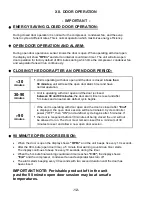
IX. TROUBLESHOOTING GUIDE
PROBLEM
POSSIBLE CAUSE/REMEDY
1. Product zone temperature too high.
1. Control Setting Too High - Reset Control
2. Inadequate Air Circulation - Rearrange Product Load To
Improve Air Circulation And Flow.
Keep Empty Trays in Position.
3. Unit May Need To Be Manually Defrosted. (Refer to Page 5.)
4. Unit May Be In Defrost Cycle. See Indicator Light. Close Door And
Wait 20 Minutes for Defrost Cycle To Finish.
5. Clean the Condenser (Refer to Page 6.)
2. Condensing unit fails to start - no hum.
1. Line Disconnected - Reconnect
2. Fuse - Replace Fuse
3. Overload Protection - Determine Reason & Correct,
Replace If Necessary
4. Unit may need to be defrosted or has tripped off due to overload.
Wait 30 minutes: Unit will self-reset.
3. Condensing unit fails to start - hums but
1. Improperly Wired - Check Wiring Against Diagram
trips on overload protector.
2. Low Voltage - Determine Reason & Correct
3. Starting Capacitor Defective - Determine Reason & Replace
4. Relay Not Closing - Determine Reason & Correct,
Replace If Necessary
5. Compressor Motor Has Winding Open Or Shorted - Replace
Compressor
6. Internal Mechanical Trouble In Compressor - Replace
Compressor
7. Unit may need to be defrosted or has tripped off due to overload.
Wait 30 minutes: Unit will self-reset.
4. Condensing unit starts, but fails to switch
1. Improperly Wired - Check Wiring Against Diagram
off of “start” winding.
2. Low Voltage - Determine Reason & Correct
3. Relay Failing To Open - Determine Reason & Correct,
Replace If Necessary
4. Run Capacitor Defective - Determine Reason & Replace
5. Excessively High Discharge Pressure - Check Discharge
Shut-Off Valve, Or Insufficient Cooling On Condenser
6. Compressor Motor Has Winding Open Or Shorted -
Replace Compressor
7. Internal Mechanical Trouble In Compressor -
Replace Compressor
5. Condensing unit starts and runs, but short
1. Additional Current Passing Through Overload Protector -
cycles on overload protector.
Check Wiring Diagram. Check For Added Fan Motors,
Pumps, etc., Connected To Wrong Side Of Protector
2. Low Voltage To Unit (or unbalanced if three phase) -
Determine Reason & Correct
3. Overload Protector Defective - Check Current - Replace Protector
4. Run Capacitor Defective - Determine Reason & Replace
5. Excessive Discharge Pressure - Check Ventilation, Restrictions In
Cooling Medium, Restrictions in Refrigeration System
6. Suction Pressure Too High - Check For Possibility Of
Misapplication. Use Stronger Unit
7. Compressor Too Hot (return gas) - Check Refrigerant Charge
(fix leak) Add If Necessary
8. Compressor Motor Has Winding Shorted - Replace Compressor
-7-
IX. TROUBLESHOOTING GUIDE (cont’d)
PROBLEM
POSSIBLE CAUSE/REMEDY
6. Condensing unit runs but short cycles on...
1. Overload Protector - See #4 Above
2. Thermostat - Differential Set Too Close
3. High Pressure “Cut-Out” Due To:
a) Insufficient Air or Water Supply - Check Air or Water
Supply To Condenser, Correct
b) Overcharge - Reduce Refrigerant Charge
c) Air In System - Purge
4. Low Pressure “Cut-Out” Due To:
a) Liquid Line Solenoid Leaking - Replace e
b) Compressor Valve Leak - Replace
c) Undercharge - Fix Leak, Add Refrigerant
d) Restriction In Expansion Device - Replace Device
7. Condensing unit operates for prolonged
1. Shortage Of Refrigerant - Fix Leak, Add Charge
periods or continuously.
2. Control Contacts Stuck or Frozen Closed - Clean Contacts or
Replace Control
3. Excessive Heat Load Placed Into Cabinet - Allow Unit
Sufficient Time For Removal Of Latent Heat
4. Prolonged or Too Frequent Door Openings - Plan or
Organize Schedule To Correct Condition
5. Evaporator Coil Iced - Defrost
6. Restriction In Refrigeration System - Determine Locations &
Remove
7. Dirty Condenser - Clean Condenser
8. Filter Dirty - Clean or Replace
9. Unit may need to be defrosted.
8. Start capacitor open or shorted or blown.
1. Relay Contacts Not Opening Properly - Clean Contacts or
Replace Relay If Necessary
2. Prolonged Operation On Start Cycle Due To:
a) Low Voltage To Unit - Determine Reason & Correct
b) Improper Relay - Replace
c) Starting Load Too High - Correct By Using Pump Down
Arrangement If Necessary
3. Excessive Short Cycling - Determine Reason For Short
Cycling (see #5 above) And Correct
4. Improper Capacitor - Determine Correct Size
9. Run capacitor open, shorted or blown.
1. Improper Capacitor - Determine Correct Size & Replace
2. Excessively High Line Voltage (110% of rated max) -
Determine Reason & Correct
10. Relay defective or burned out.
1. Incorrect Relay - Check & Replace
2. Incorrect Mounting Angle - Remount Relay In Correct
Position
3. Line Voltage Too High or Too Low - Determine Reason &
Correct
4. Excessive Short Cycling - Determine Reason (see #5 above)
& Correct
5. Relay Being Influenced By Loose Vibrating Mounting -
Remount Rigidly
6. Incorrect Run Capacitor - Replace With Proper Capacitor
-8-
Содержание RAC37
Страница 11: ...10 X WIRING DIAGRAM V 15 0 2 Stage V 15 0...
































